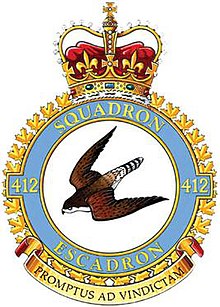| This article needs additional citations for verification. Please help improve this article by adding citations to reliable sources. Unsourced material may be challenged and removed. Find sources: "412 Transport Squadron" – news · newspapers · books · scholar · JSTOR (February 2013) (Learn how and when to remove this message) |
| 412 Transport Squadron | |
|---|---|
 | |
| Active | 1941–present |
| Country | |
| Branch | |
| Role | VIP transport and general duties |
| Home station | Ottawa, Ontario |
| Motto(s) | Promptus Ad Vindictam ("Swift to avenge") |
| Battle honours |
|
| Insignia | |
| Squadron Badge | A falcon volant |
| Aircraft flown | |
| Transport | CC-144 Challenger |
No. 412 Transport Squadron is one of three Royal Canadian Air Force (RCAF) transport squadrons attached to Ottawa, Ontario. The squadron operates with a strength of about 29 out of the Pilot Officer John Gillespie Magee, Jr. Annex. The Annex officially opened on January 11, 1995.
No. 412 Squadron began as a unit of the RCAF during the Second World War.
History

Second World War
No. 412 (Transport) Squadron was formed in 1949, but traces its history back to two separate squadrons: Number 12 Communications Flight at RCAF Station Ottawa and 412 (Fighter) Squadron, which was formed at RAF Digby, England on 30 June 1941.
John Gillespie Magee, the author of the famous aviation poem, High Flight, was serving with 412 Squadron when he was killed in a mid-air collision in his Spitfire in 1941.
No. 412 Squadron (squadron code 'VZ') was equipped with the Supermarine Spitfire Vb and served at a number of RAF Stations in the United Kingdom In October 1943, the squadron joined RCAF 126 Wing, part of the RAF Second Tactical Air Force. It was re-equipped with the Supermarine Spitfire IXb in November and began operating over northern France in preparation for Operation Overlord, the D-Day landings. It was during late 1943 that the ace George "Screwball" Beurling scored his last air victory while serving with the squadron. On July 17, 1944, 412 Squadron pilot Charley Fox seriously injured Field Marshal Erwin Rommel during a strafing run.
The squadron was moved to France in June 1944, days after the Allied landings and operated on continental Europe for the remainder of the war. The squadron was based at Wunstorf, Germany when the war ended in May 1945.
Postwar
After the Second World War, Number 12 Communications Flight was reassigned as 412 Squadron on 1 April 1947, and renamed 412 (Composite) Squadron based at Rockcliffe. In 1955, the 412 moved to Uplands. In the late 1970s a sub-unit was established at CFB Lahr in West Germany. This operation closed in 1993.
In 1994, CFB Ottawa (Uplands) closed and 412's fleet was moved to a civilian hangar at Ottawa International Airport. All aircraft are maintained by Transport Canada on behalf of the Canadian Forces.
Current role
Today, 412 (Transport)Squadron provides executive transport for the Office of the Governor General, members of Parliament, high-level government officials, members of the Canadian Armed Forces, and foreign VIPs while they are in Canada. 412 (T) Sqn also provides aeromedical evacuation and transport.
Aircraft operated
Aircraft previously used by 412:
- Supermarine Spitfire
- North American Harvard
- Beechcraft Expeditor
- Douglas Dakota
- 1 Canadair North Star 1949–1966
- 2 de Havilland Comet 1A 1953–1963
- 2 Canadair CC-106 Yukon 1961–1978 - VIP configuration
- 1 de Havilland Canada CC-132 (Dash 7) - based at Lahr 1980–1987
- 2 de Havilland Canada CC-142 (Dash 8) - based at Lahr 1987–93
- 1 Canadair CC-109 Cosmopolitan 1960–1980
- 7 Dassault CC-117 (Falcon) 1968–1985
Aircraft currently used by 412:
- 4 Canadair CC-144 Challenger business jets.
See also
- Royal Canadian Air Force VIP aircraft
- Bombardier Challenger 600
- Air transports of heads of state and government - Canada
References
- DND - Canada's Air Force - History Retrieved 2015-12-15
- "412 Transport Squadron". CMP: Directorate of History and Heritage. 2013. Retrieved 10 September 2013.
- "412 Squadron". raf-lincolnshire.info. 2012. Retrieved 10 September 2013.
- ^ "No. 412 Squadron". canadianwings.com. 2013. Retrieved 10 September 2013.
- "Combat Reports, Second World War: Image details, Beurling, Flight Lieutenant, 30 December 1943." DocumentsOnline, The National Archives. Retrieved: 29 July 2009.
- "Spitfire pilot 'Flying Fox' remembered for veterans' work". CBC. Retrieved 2 July 2022.
- "412 Transport Squadron". Royal Canadian Air Force. 2013. Archived from the original on 5 September 2013. Retrieved 10 September 2013.
Further reading
- 412 (Transport) Squadron, 1936-1995. Paducah, Kentucky: Turner Publishing. 1995. ISBN 1-56311-011-3.
External links
- Flying Officer L.R.N. Ashley (August 1958). "The Story Of No. 412 Squadron" (PDF). The Roundel. Vol. 10, no. 6. Royal Canadian Air Force. Archived from the original (PDF) on 10 August 2014.
45°19′21″N 075°40′09″W / 45.32250°N 75.66917°W / 45.32250; -75.66917 (CYOW)
| Squadron numbers |
| ||||||||||||||||||||||
|---|---|---|---|---|---|---|---|---|---|---|---|---|---|---|---|---|---|---|---|---|---|---|---|
| Squadron codes |
| ||||||||||||||||||||||
| Aircraft administered and serviced by the RCAF but manned by the Royal Canadian Artillery.
Non-standard code as unit using OW added L. Letters normally denoted parent Command, aircraft type (L Liberator transport, D Dakota etc), unit, and individual aircraft. VC XX | |||||||||||||||||||||||
| Canadian Armed Forces | |
|---|---|
| Military history | |
| Leadership | |
| Commands | |
| Academies | |
| Lists | |
| Others | |